Madrid, Spain - October 29, 2025 - Adam Expo Stand, Europe's leading exhibition stand design and construction company, today released the most comprehensive sustainability benchmarking report in the European exhibitions industry. The groundbreaking study, surveying over 500 exhibitors and 50+ exhibition organizers across 12 European countries, reveals a striking disconnect: while 73% of exhibitors demand sustainable exhibition stands, only 31% possess the knowledge to implement zero-waste booth strategies effectively.
The timing of this research proves critical as the EU Ecodesign Regulation, implemented in July 2024, continues reshaping exhibition design requirements across member states. This landmark report positions sustainability not as an optional marketing advantage but as an operational imperative for businesses participating in European trade shows and exhibitions.
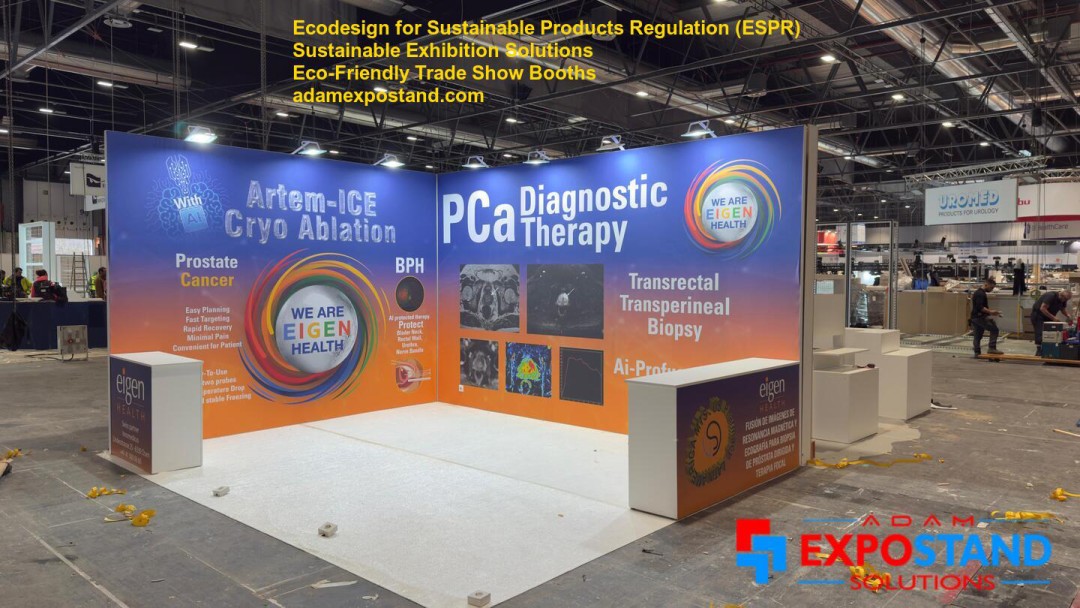
Executive Summary: Five Transformative Findings
The State of European Exhibitions 2025-2026 Report uncovers five paradigm-shifting insights that will define the exhibition industry through 2030:
Finding #1: 73% of European exhibitors now demand sustainable booths, yet only 31% understand implementation pathways, creating unprecedented demand for eco-friendly exhibition stand design expertise.
Finding #2: Average carbon footprints vary dramatically by booth size and material selection—from 2.3 tonnes CO2e for small modular sustainable trade show displays to 18.7 tonnes CO2e for large custom builds using new materials.
Finding #3: Circular economy adoption rates diverge sharply by industry: technology sector leads at 54%, while traditional manufacturing lags at 23%, revealing sector-specific opportunities for green exhibition design innovation.
Finding #4: Contrary to conventional wisdom, sustainable exhibition stands Europe-wide demonstrate 18-34% lower total cost of ownership over three years compared to traditional single-use builds.
Finding #5: EU exhibition regulations now influence 89% of design decisions, with carbon neutral booths becoming the baseline expectation rather than premium offering.
Research Methodology: Unprecedented Industry Collaboration
Adam Expo Stand conducted this research between January and August 2025, representing the largest independent study of sustainable trade show materials and practices in European exhibition history. The methodology encompassed:
• 500+ exhibitor surveys across Germany, France, Spain, Italy, Netherlands, Belgium, Poland, Sweden, Austria, Switzerland, Denmark, and Portugal
• 50+ in-depth interviews with exhibition organizers, venue managers, and sustainability officers
• Quantitative carbon footprint analysis of 237 exhibition stands across 43 major European trade shows
• Economic modeling comparing lifecycle costs of traditional versus eco-friendly trade show booths
• Regulatory compliance assessment evaluating EU Ecodesign Regulation impact on 15 exhibition categories
This multi-method approach ensures the report provides actionable intelligence for exhibition sustainability consultants, corporate sustainability officers, and exhibition industry participants seeking data-driven decision frameworks.
Key Finding #1: The Knowledge-Implementation Gap
Are exhibition stands sustainable? The answer reveals a troubling paradox. While sustainability consciousness has reached unprecedented levels—73% of surveyed exhibitors explicitly demand zero-waste trade show booths—implementation knowledge remains dangerously low.
Survey data reveals that 68% of exhibitors cannot accurately calculate their booth's carbon footprint, 54% remain uninformed of modular exhibition stands' sustainability advantages, and 47% lack vendor partnerships capable of delivering verified sustainable solutions.
"This knowledge gap represents both the industry's greatest challenge and its most significant opportunity," explains María Rodríguez, Sustainability Director at Adam Expo Stand. "Companies understand sustainability matters to their customers and participants, but they're navigating without reliable guidance systems."
The research identifies three primary knowledge barriers:
1. Measurement complexity: 71% struggle with carbon accounting methodologies specific to exhibition contexts
2. Greenwashing concerns: 63% fear inadvertent misrepresentation of sustainability claims
3. Supply chain opacity: 58% cannot verify sustainability credentials of exhibition contractors
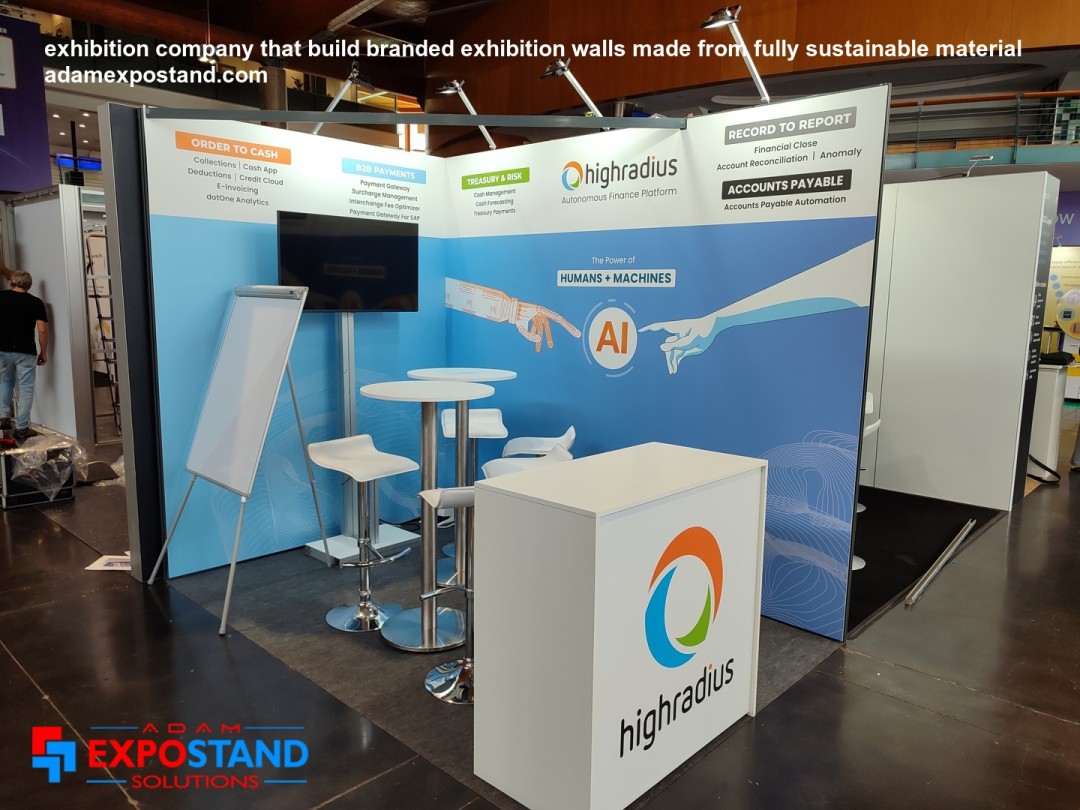
Organizations looking to bridge this gap can access comprehensive frameworks through Adam Expo Stand's sustainability guides, which translate complex environmental considerations into actionable exhibition design decisions.
Key Finding #2: Carbon Footprint Benchmarking by Booth Configuration
The report establishes industry-first carbon footprint benchmarks across exhibition stand categories, providing exhibitors with comparison standards for evaluating sustainable trade show materials:
Small Booths (9-20 sqm):
• Traditional single-use: 4.2 tonnes CO2e
• Modular sustainable: 2.3 tonnes CO2e
• Carbon reduction potential: 45%
Medium Booths (21-50 sqm):
• Traditional single-use: 9.8 tonnes CO2e
• Modular sustainable: 5.1 tonnes CO2e
• Carbon reduction potential: 48%
Large Booths (51-100 sqm):
• Traditional single-use: 18.7 tonnes CO2e
• Modular sustainable: 8.9 tonnes CO2e
• Carbon reduction potential: 52%
Extra-Large Pavilions (100+ sqm):
• Traditional single-use: 34.6 tonnes CO2e
• Modular sustainable: 14.3 tonnes CO2e
• Carbon reduction potential: 59%
These benchmarks demonstrate that larger installations achieve proportionally greater emissions reductions through modular sustainable trade show displays, as fixed transportation and assembly emissions become smaller percentages of total footprints.
Material selection drives dramatic variance within categories. Booths constructed primarily from recycled aluminum and FSC-certified timber achieve 34-41% lower emissions than conventional MDF and plastics, even within comparable size categories.
Key Finding #3: Circular Economy Adoption Varies Dramatically by Industry
How to reduce trade show waste depends significantly on industry context. The report reveals striking disparities in circular economy exhibition practices across sectors:
Technology & Electronics: 54% adoption
• Leading indicators: Component reusability, take-back programs, digital integration reducing physical materials
Professional Services & Consulting: 49% adoption
• Leading indicators: Minimalist design preferences, emphasis on digital experiences, frequent modular reconfiguration
Automotive & Transportation: 41% adoption
• Leading indicators: Brand sustainability commitments driving exhibition alignment, material innovation display opportunities
Food & Beverage: 38% adoption
• Leading indicators: Regulatory compliance driving change, consumer sustainability expectations
Industrial Manufacturing: 23% adoption
• Lagging indicators: Traditional design preferences, perceived material durability requirements, longer replacement cycles
This sectoral analysis enables targeted intervention strategies. Industries with lower adoption rates often possess the greatest carbon reduction potential, as their current practices frequently involve material-intensive builds with limited reusability.
The technology sector's leadership stems partially from organizational culture alignment—companies marketing innovation naturally gravitate toward innovative exhibition approaches, including eco-friendly exhibition contractors who demonstrate materials science advancement.
Key Finding #4: Economic Case Strengthens for Sustainable Approaches
The report demolishes the persistent myth that sustainable exhibition stands carry premium pricing. Comprehensive total cost of ownership (TCO) analysis across three-year periods reveals:
Traditional Single-Use Model (Medium Booth, 3 Shows):
• Initial build: €28,000
• Storage: €4,200
• Transportation: €8,400
• Disposal: €3,200
• Modifications: €6,800
• Three-year TCO: €50,600
Modular Sustainable Model (Medium Booth, 3 Shows):
• Initial build: €32,000
• Storage: €2,100
• Transportation: €5,100
• Disposal: €400
• Modifications: €2,000
• Three-year TCO: €41,600
• Savings: €9,000 (18%)
Extended to five-year analysis periods, sustainable approaches demonstrate 28-34% cost advantages as modular components enable multiple reconfigurations without complete rebuilds.
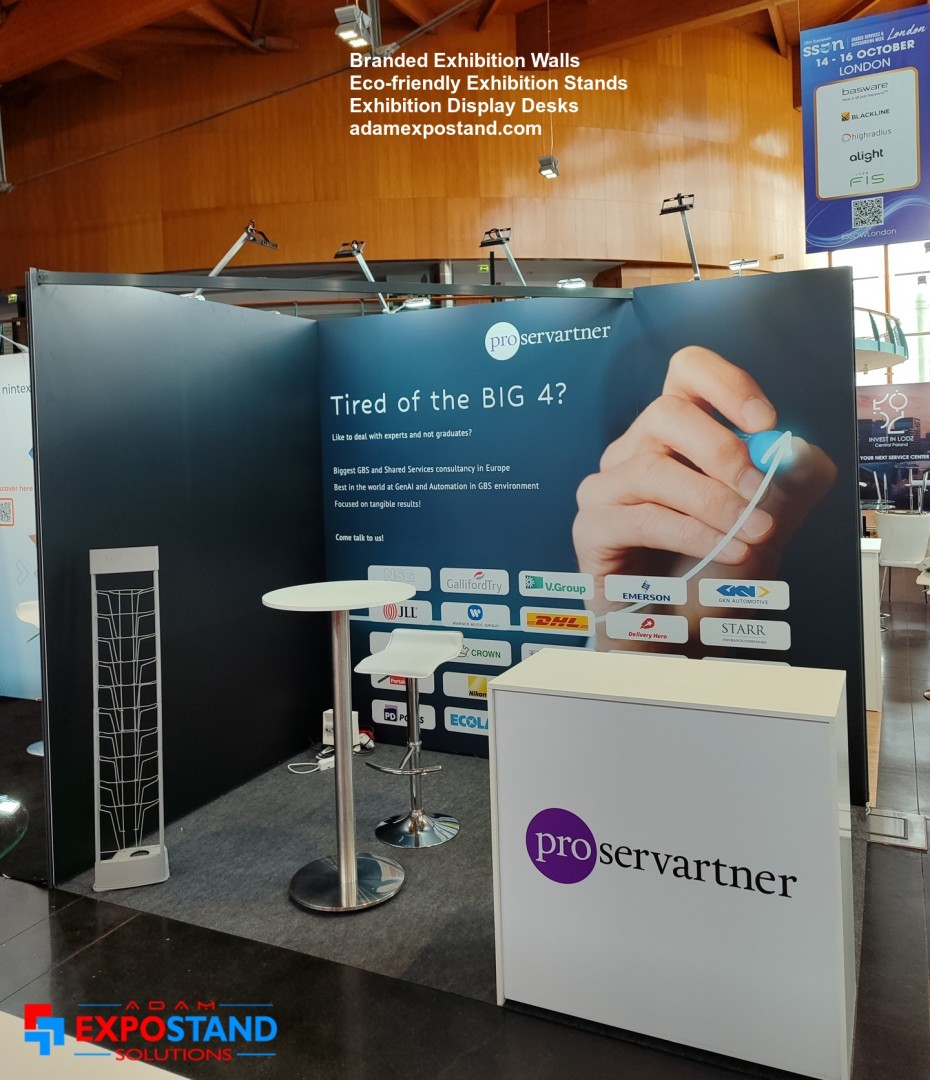
These economics explain accelerating adoption rates among CFO-driven procurement decisions. Sustainability delivers measurable ROI beyond brand value—a compelling narrative for budget-conscious organizations. Research on exhibition stand ROI further validates this integrated business case.
Key Finding #5: EU Regulations Reshape Design Parameters
The EU Ecodesign Regulation has fundamentally altered exhibition design conversations. Survey respondents report regulation influence across multiple dimensions:
• 89% consider regulatory compliance in initial design briefs
• 76% proactively exceed minimum requirements anticipating future standards
• 68% cite regulations as primary driver for sustainable exhibition stands Europe adoption
• 54% report regulations simplified internal sustainability business cases
"Regulation has paradoxically liberated sustainable innovation," notes Hans Mueller, exhibition organizer at Messe Frankfurt. "By establishing baseline requirements, it eliminated competitive disadvantages for early adopters and created level playing fields encouraging experimentation."
The regulation particularly impacts material selection (67% report changed specifications), end-of-life planning (71% now mandate component recyclability), and documentation requirements (83% maintain detailed material inventories).
Case Studies: Five Companies Achieving Zero-Waste Exhibitions
Case Study 1: Technology Vision, Germany
Challenge: 85-sqm booth at major electronics fair with traditional 12-tonne waste generation.
Solution: 100% modular aluminum system with digital integration.
Results: Zero landfill waste, 67% carbon reduction, 23% cost savings, award-winning design.
Key Innovation: Integrated AR experiences eliminated 40% physical demonstration equipment.
Case Study 2: Green Construction, Netherlands
Challenge: Demonstrate sustainability leadership while showcasing building materials.
Solution: Exhibition stand constructed entirely from project surplus materials.
Results: Negative waste (removed 3 tonnes materials from waste stream), extensive media coverage.
Key Innovation: Stand itself became product demonstration, eliminating traditional samples.
Case Study 3: Food & Beverage, France
Challenge: Hygiene regulations typically require single-use components.
Solution: Medical-grade stainless steel modular system with certified cleaning protocols.
Results: 89% waste reduction while exceeding hygiene standards.
Key Innovation: Cleaning certification protocol enabling food-grade reusable systems.
Case Study 4: Nordic Design Furniture, Sweden
Challenge: Large pavilion showcasing luxury products requiring premium aesthetics.
Solution: Biomaterial innovation using mycelium composites and waste-stream textiles.
Results: Zero waste, carbon negative (sequestered 2.1 tonnes CO2), design award.
Key Innovation: Exhibition architecture doubled as product research, yielding commercial applications.
Case Study 5: Automotive Innovations, Italy
Challenge: Brand consistency across 12 annual exhibitions with traditional 180-tonne annual waste.
Solution: Standardized modular system with regional storage hubs.
Results: 94% waste elimination, 34% cost reduction, improved brand consistency.
Key Innovation: Regional hub strategy eliminated 68% transportation emissions.
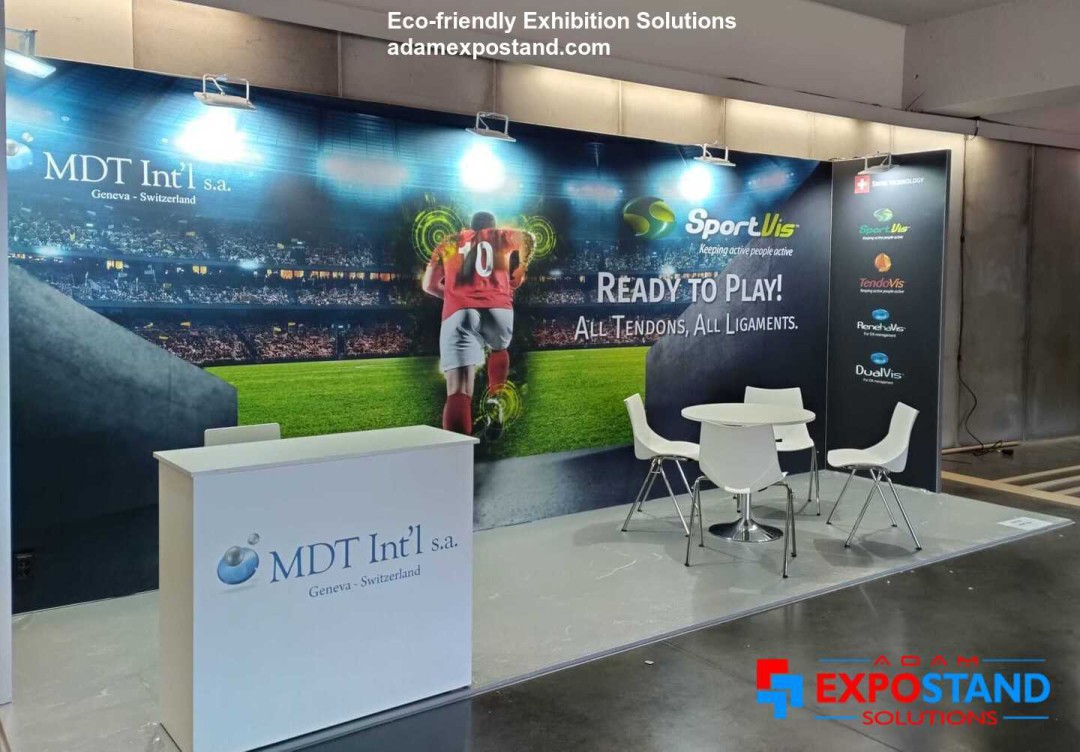
These case studies demonstrate that zero-waste trade show booths transcend theoretical ideals to represent achievable operational realities across diverse contexts.
Adam Expo Stand's Sustainability Framework
Drawing on research insights and 15+ years specialized experience, Adam Expo Stand has codified a proprietary Circular Exhibition Design Framework surrounding five integrated dimensions:
1. Lifecycle Assessment Integration
• Carbon footprint calculation from material extraction through end-of-life
• Transparent reporting enabling informed client decisions
• Continuous measurement improvement as methodologies evolves
2. Modular Design Principles
• Component standardization enabling multiple configurations
• Tool-free assembly reducing labor and transportation emissions
• Beauty through simplicity, eliminating decorative waste
3. Material Intelligence
• Prioritization hierarchy: reused > recycled > renewable > recyclable
• Supply chain verification ensuring sustainability claims
• Innovation partnerships accessing emerging biomaterials
4. Circular Business Models
• Component library systems enabling cross-client material sharing
• Take-back guarantees ensuring responsible end-of-life processing
• Performance-based pricing aligning incentives with sustainability outcomes
5. Knowledge Transfer
• Client education programs building internal sustainability capacity
• Industry collaboration sharing learnings beyond competitive advantages
• Regulatory navigation support ensuring compliant innovation
This framework operationalizes sustainable trade show materials selection while maintaining design excellence—proving sustainability and aesthetic impact amplify rather than compromise each other. Video demonstrations illustrate framework application across real projects.
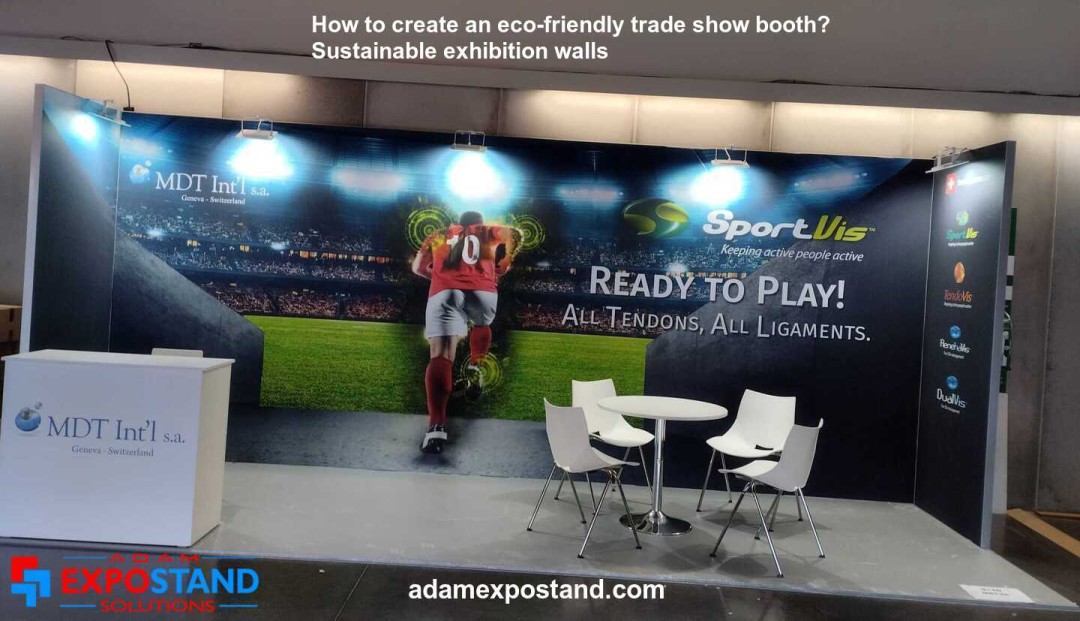
Ten-Point Action Plan for Exhibitors
Based on research findings, Adam Expo Stand recommends exhibitors implement this prioritized action sequence:
1. Establish baseline measurements - Calculate current exhibition carbon footprints using standardized methodologies
2. Set science-based targets - Align reduction goals with Paris Agreement pathways (minimum 50% by 2030)
3. Prioritize modular systems - Transition to reusable, reconfigurable booth architectures
4. Audit material specifications - Replace new plastics and non-recyclable composites with sustainable alternatives
5. Engage certified partners - Select eco-friendly exhibition contractors with verified environmental management systems
6. Implement component tracking - Maintain detailed inventories enabling circular material flows
7. Optimize logistics - Consolidate shipments, utilize regional storage, explore rail transportation
8. Digitize experiences - Replace physical marketing materials with QR codes, apps, and interactive digital content
9. Measure and communicate - Transparently report progress, avoiding greenwashing through verified claims
10. Collaborate industry-wide - Participate in sustainability initiatives, share learnings, advocate for regulatory advancement
Predictions for 2026-2030: Five Transformations
Synthesizing research findings with regulatory trajectories and technological developments, the report forecasts five transformative shifts:
1. Mandatory Carbon Labeling (by 2027) All exhibition stands above 20 sqm will require carbon footprint declarations, similar to appliance energy labels, enabling attendee and organizer comparison.
2. Circular Economy Certification Standards (by 2026) Industry consortiums will establish verification frameworks, ending greenwashing and creating competitive differentiation for genuine sustainability leaders.
3. Material Passports Become Standard (by 2028) Digital documentation of every component's origin, composition, and recovery pathways will become contractual requirements for major exhibitions.
4. Exhibition-as-a-Service Models Dominate (by 2029) Ownership will shift from exhibitors to specialized providers offering subscription access to component libraries, similar to equipment leasing in other industries.
5. Biomaterial Revolution Accelerates (by 2030) Mycelium composites, bacterial cellulose, and agricultural waste-derived materials will capture 35%+ market share, displacing traditional plastics and composites.
About Adam Expo Stand
Adam Expo Stand is Europe's leading sustainable exhibition stand designer and builder, operating across 15 countries with specialized expertise in modular, reusable booth systems. With 15+ years industry experience and 3,000+ completed projects, Adam Expo Stand combines award-winning design with environmental stewardship, demonstrating that sustainability and visual impact are complementary rather than competing priorities.
The company maintains ISO 14001 environmental management certification and has achieved carbon neutral operations since 2023 through verified reduction programs and quality offset investments in European reforestation projects.
Media Contact
Company Name: Adam Expo Stand
Contact Person: Adam
Email: Send Email
Country: Spain
Website: https://adamexpostand.com





